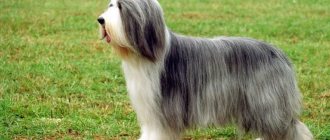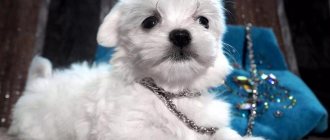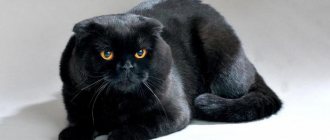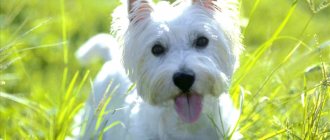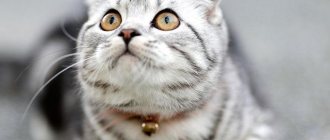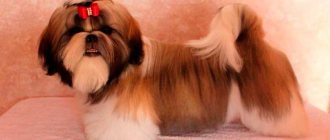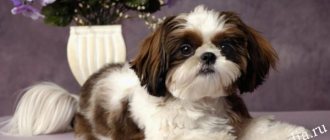Toy terriers are miniature and decorative dog breeds.
They have a cute and harmless appearance. But often the appearance of such a baby conceals its own individual character, which requires a certain approach.
Despite their small size, they require special care and attention.
Many owners, comparing toy terriers with other breeds (for example, Chihuahuas), say that in some ways they are even more difficult to keep than other types of dogs.
Origin of the breed
The breed was very popular among the European aristocracy in the late 19th and early 20th centuries. Miniature English Toy Terriers were bred in Great Britain by crossing dogs of decorative and hunting breeds.
Manchester terriers, small English greyhounds and Italian greyhounds left their mark on the pedigree of toy terriers. Initially bred for hunting small burrowing animals, the breed soon began to be considered decorative, “sofa”. It was customary to have such dogs in noble houses, carry them with you, and take them on trips. From Europe, the “travelers” reached Russia, where difficult times awaited the breed at the beginning of the last century.
The October Revolution changed the mentality of the people. And everything that was previously considered aristocratic, “lordly” was stigmatized and quickly forgotten. Dogs with a characteristic noble reputation did not fit into the new ideology of society. From the 20s to the 50s, no breeding work was carried out with the breed at all. The situation changed only in 1956, when Soviet cynologists announced the start of work on breeding “our” Russian Toy Terrier breed.
Already in the late 50s, the first smooth-haired representatives of the breed were bred, very similar in appearance and character to their British counterparts. They called them Russian Toy Terriers. Just two years later, breeders introduced long-haired dogs called Moscow Toy Terriers. Since then, breeding work has not stopped.
from the personal archive / Olga Moskaleva
In the mid-90s, the first national breed club appeared in Moscow, and a year later the first exhibition was held. But the results of the work of Soviet breeders were not recognized internationally for a long time. The standards recognized by the Fédération Cynologique Internationale turned out to be different from the description of the Toy Terrier breed bred by Soviet breeders. It was only in 2006 that the breed received conditional recognition from the international community. But it was renamed: the word terrier disappeared from the name, since experts agreed that these dogs had nothing in common with terriers. And Russian and Moscow Toy terriers were combined into one standard - Russian Toy, which applies to smooth-haired and long-haired representatives.
Russian Toys received final recognition in 2022, and today breeders have the right to represent their pets at the Fédération Cynologique Internationale championships.
Training
Toy terriers are taught order from an early age. The dog should not beg for treats, go to the toilet in the wrong place and bark for no reason. The puppy is clearly shown what is required of him, and the result is reinforced with a treat. An adult Toy is trained differently: he is scolded for unfulfilled commands and praised for his successes.
Dogs should not be trained by shouting and punishment. They will hold a grudge and will not respond to orders.
In addition, it is useful to teach toys standard commands: fu, come to me, next to me, sit, lie down. To prevent your pet from showing aggression towards other people's dogs and people, it needs to be socialized in time. It is best to start this process after the first vaccinations.
What does a toy terrier look like?
These are miniature dogs with long thin legs, their weight is 1.5-3 kg, and their height at the withers should not exceed 28 cm.
“The weight of a dog is not as important as its proportions,” notes dog handler Olga Moskaleva. — The shape must be square, that is, the height at the withers must be equal to the length of the body. A slight deviation from the norm is allowed; the body can be extended a little more. But the dog should not have shortened paws. This is an elegant, aristocratic breed, which is primarily manifested in its exterior.”
The baby’s body is compact, well-built, “strong” and “dry” in appearance. The beautifully curved neck is crowned by a wedge-shaped head with a wide skull, erect triangular ears and protruding eyes. The tail is thin, raised and slightly curved upward.
from the personal archive / Olga Moskaleva
The Smooth-haired Toy Terrier has a close-lying, short and shiny coat without undercoat. The longhair is distinguished by a coat up to 5 cm long, which can be straight or slightly wavy, but always tight-fitting and not hiding the lines of the body. The hair on the paws is longer, and on the ears it is so thick and long that it hangs down like a fringe. This “mane” is considered both an adornment and a “calling card” of the long-haired Russian Toy.
The colors of toy terriers are varied. These babies are not only black, although this color is considered a classic of the breed and dogs of this color are more common than others. The standard allows wool of other, beautiful and even unexpected colors:
- brown and tan;
- fawn - light cream shade;
- blue and tan - a spectacular shade with an admixture of blue and gray;
- isabella - a pale gray shade with yellowness;
- red - in different shades and with an admixture of chocolate and black colors.
“The main thing is that there are no white spots in the color, neither on the paws nor on the belly,” notes breeder Olga Moskaleva. “According to the breed standard, this is considered a marriage.”
Afterword
Which breed is smarter, better or worse, only an experienced owner can say. Each dog, regardless of breed (or its presence), color, size, age and other criteria, is unique. A four-legged animal is a personality with its own mentality, mood and emotions.
The “lion’s share of a dog’s goodness” depends on the upbringing and responsibility of the owner. If the trainer does not have a core, each dog will be difficult to train; if the owner does not have enough time for his pets, they will all be bandits and destroyers. Before you evaluate a breed, much less accept someone else’s opinion as true, evaluate your strengths and capabilities.
Note! All official characteristics and breed standards describe the general impression of pedigree dogs. Mestizos, crossbreeds and phenotypes are outbred animals, the character of which cannot be spoken with certainty.
Chihuahuas and Toy Terriers are breeds that have been popular for many years.
But despite their external similarity and small size, their features are completely different.
Only knowing this can you choose a dog that is completely suitable for yourself and your family.
But Chihuahuas and toy terriers are not as similar as they seem at first glance.
How do you choose?
Let's look into it in detail.
Character of the toy terrier
Russian Toys are mistakenly perceived as sofa or “pocket” dogs, who are afraid of everything around them, and walk along the street on weak, trembling legs. A dog can indeed tremble during a walk, but not from fear, but from excessive excitement, when it is ready to rush into battle to protect its owner. Or when her activity goes over the edge, and the pet cannot cope with the flow of emotions overwhelming him. The second reason for trembling is the cold, to which they are extremely susceptible.
“Since I am a breeder of several decorative dog breeds, I am often asked who to choose - a Chihuahua or a toy terrier,” comments Olga Moskaleva. — Previously, when I first started working with toy dogs, I answered: if you need a loyal dog, choose a Chihuahua. And it doesn’t matter whose hands caress him, as long as he always has food. Over time, I radically changed my attitude towards the breed. And I can say that these are brave, loving and devoted pets, true companions, ready to accompany you everywhere. At the same time, long-haired toys are more temperamental compared to smooth-haired ones.”
This baby will closely monitor its owner when he is at home and will never go to sleep in his presence. He will participate in all family events and literally follow the owner's heels. Toys get along well with children and enjoy playing with them. But they are susceptible to stress and become nervous if they often hear screams, loud noises around them, or children’s games are too active for them.
On the street they do not give in to representatives of large breeds. And breeders note that these babies are completely devoid of a sense of fear and awareness of their miniature size. Because of this, it is advised to deliberately limit the babies’ contacts with large pets, as they can cause injury to the toy babies.
from the personal archive / Olga Moskaleva
Basic moments
Breed characteristics:
- Excellent memory
- Lack of aggression
- Innate protective qualities
- Due to their small size they feel good in small apartments
- Not bad for training
The Toy Terrier is a naturally stubborn species that needs to be approached. He does not accept the authoritarian style. In the process of subsequent training, any psychological pressure should be excluded.
Professionally presses for pity, gradually studying the owner. Able to make friends with other pets.
Any sharp sound will be accompanied by a piercing bark. You should start training your toy terrier as early as possible.
Toys have low stress resistance, which is why they are not recommended for families with small children.
How long do toy terriers live at home?
The average lifespan of dogs of this breed is 12-15 years, but their miniature size and exceptional elegance require special conditions for puppies. Children often get injured due to the simple carelessness of their owners.
“When purchasing a puppy, you must definitely buy a metal playpen for him,” advises breeder Olga Moskaleva. “This is not a cage or a place of punishment. This is a device that will protect your dog from injury in your absence, create its own place in the apartment, and provide the necessary conditions for a relaxing holiday without risks.”
And there are plenty of risks for a little toy even in an ordinary apartment. Babies weighing less than 800 grams, as they arrive at the owner’s house at the age of two to three months, easily fit in the palm of your hand. The owner may kick the baby away without noticing. Or the baby may crawl under a closet or sofa and get stuck there. Finally, in the absence of the owners of the points, it will be happy to explore everything around and will definitely taste the wires if it discovers them along the way. All this is dangerous, and can not only undermine the health of the baby from the first months of his life, but also cause the death of the puppy. Therefore, purchasing a playpen where the puppy will spend most of the day is extremely important. When the baby grows up, the need for a playpen will disappear.
It is also worth paying attention to the following points.
- A toy terrier's teeth begin to change at the age of six months. At this time, it is necessary to give the baby treats in the form of hard bones (for example, from veins) to help in changing the bite. Sometimes baby teeth do not fall out on their own, while the molars are already growing. If this happens, you need to contact a veterinarian who will help remove the extra teeth.
- Walking in winter should be limited as much as possible. In frosty weather, your pet freezes and may catch a cold. Clothes for a toy terrier are a must for walking in winter. But even in a warm overall, you shouldn’t go on long festivities.
- The dog must not be thrown or forced to jump from a height. Your pet's bones are thin, so a fall can cause injury. The permissible jumping height for a toy is the one to which he himself can jump. Nothing bad will happen if he jumps off the couch or walks down the stairs. But putting it on a bookshelf or refrigerator is deadly, so it is important to supervise your pet when children play with it.
Selection rules
By purchasing an animal, a person takes on a friend for many years. Therefore, it is important to know what kind of toy terrier puppies should be. What you need to pay attention to:
- baby's behavior;
- parents;
- conditions of keeping the bitch and her litter;
- to the breeder.
A toy terrier puppy should give the impression of being a nimble animal and not differ from the rest of the litter. The coat is smooth, shiny, without defects, clean eyes and teeth.
It’s good if you have the opportunity to observe the parents of the toy terrier puppy. Most likely, he will turn out to be similar to them. If a dog's mother or father is aggressive, the offspring may become the same.
It is important to see in what conditions animals grow, mature, and their nutrition. You need to decide in advance who to choose, a girl or a boy. Determine the age of the toy terrier.
A good breeder will easily answer questions about the development of the puppy after birth, give advice, addresses of good veterinary clinics, and recommend food for the pet.
Expert opinion
Anna Abramenko
An avid dog lover. Experience in veterinary medicine since 2009.
Ask a Question
An animal is not a toy that can be changed. In order not to get confused and not be led by chance, it is better to create a table of signs that will help when buying a dog.
What time do toy terrier ears stand up?
Your pet's ears are another indicator of health that you need to pay attention to. In the first weeks of life they can “lie down”, but as they grow older they must rise. This happens because the ear cartilage, initially very thin and soft, becomes stronger. For some babies this happens at two months, for others at four. ears up to six months. But if this did not happen, or the ears “fell”, you need to figure out why.
The first reason is an unbalanced diet. If a dog is fed a “natural diet,” it may lack calcium, resulting in weak cartilage tissue.
The second reason is heredity. If the puppy was not purchased from a nursery or from, there is a high probability that there are “gaps” in its pedigree. Ears may droop if there were many long-haired ones in the family of the smooth-haired toy. Genetic abnormalities cannot be changed either by diet or by trying to “adjust” the dog’s ears.
Of course, you won't stop loving a puppy for its drooping ears. But this will block the way to exhibitions, since it does not fit into the breed standards.
from the personal archive / Olga Moskaleva
Appearance
The toy terrier, a photo of which you can see in our article, has an elegant but fairly strong build, slender limbs, a small head with large erect ears. The eyes are large and dark. The coat is smooth and shiny.
The Toy Fox Terrier is a hunting dog, participant in exhibitions, and companion. Despite its miniature size, it remains a working dog. The animal is capable of hunting small rodents. The American Toy Terrier dog breed is widespread in Russia. With proper training, he becomes an excellent companion.
What to feed your toy terrier
Nutrition has a direct impact on a dog’s health, so you need to approach the choice of food responsibly. According to breeder Olga Moskaleva, choosing a balanced diet from natural products is very difficult. And there is always a risk that you will overfeed your dog. And at the same time, she will not receive all the substances her body needs.
And since Toys are prone to overeating by breed, it would be correct to feed your pet with complete dry food intended for small breeds, specifying the recommended age. First it will be puppy food, which has increased calcium and glucosamine content. After 10 months, you can switch to food for adult dogs.
The breeder will help you choose food. As a rule, nurseries work with super-premium food from certain manufacturers. And already from the third week after birth, the puppy becomes familiar with this diet. If it suits the baby and does not cause eating disorders or allergic reactions, there is no need to change it.
Health and diseases of the Russian Toy
Representatives of the breed are considered strong dogs that rarely get sick. Despite this, increased attention should be paid to the health of your pet.
In a few days, from a cheerful four-legged animal, the animal can turn into an exhausted and lethargic dog. Conventionally, diseases can be divided into several categories.
- skin diseases
- allergy
- dental problems
- diseases associated with the musculoskeletal system
- Gastrointestinal tract
- neuralgia
Eye diseases are common. The animal can also pick up parasites, infections and viruses. We should not forget about genetic predisposition. We are talking about conjunctivitis and cataracts.
Puppy in the house - care and education
“Dogs do not require special living conditions,” notes breeder Olga Moskaleva. — You need to vaccinate your toy terrier on time, feed him dry food and worm him no more than once every six months and 2 weeks before vaccination. Despite their apparent fragility and miniature size, they have excellent health.”
The expert advises interfering as little as possible with your pet’s health. He does not need to be bathed regularly. Moreover, this should only be done if absolutely necessary. When bathing with shampoo, the protective barrier is washed away from the surface of the skin. This leads to dry skin and dandruff, as well as a “dog” odor, which is not typical for small breed dogs. Usually the one smells like the house in which he lives, or the bed, if the owners let him into the bed. And it begins to smell like “dog” due to frequent bathing, in response to which the animal’s skin begins to actively produce a secretion with a specific odor.
Olga Moskaleva also does not recommend cleaning a dog’s ears and eyes, as it only depresses the animal’s immunity and leads to inflammation. And among the mandatory grooming procedures, he only lists nail trimming once every two weeks. Due to the light weight of the animal, the claws do not have time to grind down on the asphalt when walking.
In the house, the puppy needs to immediately set boundaries and make it clear what he can do and what he cannot do. You shouldn’t wait for your baby to grow up and allow him to do things today that you wouldn’t want to see in the behavior of an adult dog tomorrow. Nowadays, small pranks, for example, a baby walking across the dining table or sleeping on the owner’s pillow, can cause affection. But in the future, your attitude towards your pet's behavior will most likely change.
“The dog does not understand that it has grown,” comments Olga Moskaleva, “it is just gaining experience. Therefore, it is very important to raise a puppy from the first seconds of being in the house. If you don't want your dog to lie on the sofa while you're away, never take it to the sofa. Immediately stop everything that you think your pet should not do.”
from the personal archive / Olga Moskaleva
Keeping a pet
Due to the lack of undercoat, the dog gets very cold even in cool weather. Therefore, dog clothes are a necessary accessory. These can be various insulated overalls, blankets, blouses, hats. You should also wear shoes. When choosing clothes, it is better to give preference to natural fabrics. To prevent ear creases, clothing should have full-length zippers, allowing you to avoid putting the item over your head.
Thin-boned toy terriers are very fragile and falling even from a small height can lead to dislocations and fractures. Therefore, the pet should not be allowed on the sofa or placed on the table. Firstly, he quickly gets used to it and begins to ask at every opportunity. And secondly, the likelihood of injury increases. A jump from a height of 1 meter can be fatal. It is better for children not to carry a pet in their arms, as a restless dog is difficult to hold and can easily slip out.
The pet needs to splash out boundless energy, so walks should be daily, or preferably 2 times a day. The dog loves to frolic, run, and is ready to fetch a ball or a stick. In winter, due to cold intolerance, walks can last no more than a couple of minutes. Accordingly, at this time it is necessary to increase activity at home. The dog must have toys - latex, rubber bones, ropes, balls, squeaking toys that resemble rodents.
If walking is not possible, the dog can be trained to use a tray. But learning should start from an early age.
When the puppy has just arrived in the house, he should not be disturbed for the first few days. This is a lot of stress for the dog and it must get used to the new environment and new people.
How to accustom a toy terrier to a diaper or tray
The toilet tray will become a lifesaver for the owners of a miniature toy. Unlike large breed dogs, these babies do not need to be taken outside regularly. The tray will eliminate this need if the weather outside is frosty, or you simply don’t want to get out from under the blanket early on a day off.
“Of course, you need to walk the dog,” says breeder Olga Moskaleva. “But a tray in the house wouldn’t hurt either.” It solves the problem of walking when you can't. The breeder must train him to use the tray. We hand over our puppies to owners who are already trained and understand what a litter box is and what it is needed for.”
If your baby does not yet know the purpose of the tray, teach him to use the toilet from the first minutes of his stay in the house. Once you bring it home, place it on the tray and praise if the baby used it correctly. When you are at home, keep an eye on the puppy and take him to the tray if you notice that he is restless or looking for something. Always praise for successful use of the toilet and give your baby a treat. Toys are smart dogs, they quickly remember why they receive praise, and try to please their owner again and again.
Key facts
The description of the Toy Terrier breed is often contradictory - some do not understand how such a small and fragile creature can be called a dog. Other people are sure: a small dog is the best companion and companion!
Indeed, the toy is a tiny creature, smaller than the average cat. But he does not notice his size and is ready to be a true devoted friend with a big heart.
He will begin to accept the owner’s commands, and even more so to carry them out, only when the person treats him with respect. These dogs categorically do not want to live in an authoritarian family, and moral pressure can result in a whole bunch of diseases for them.
However, if you indulge your dog too much, this sly one will quickly figure out all your weaknesses and take control into his paws. And then you will be his dog - that’s why it’s important to raise your baby.
The characteristics of the Toy Terrier breed emphasize their vulnerable nervous system - shouting at them is strictly prohibited! In general, it is better to exclude factors in the house that can provoke stress in the animal.
A trained and socialized dog will feel comfortable in any situation - on the street, in a car, in a house with a lot of guests. The main thing is that your beloved owner is nearby.
The size of the toy terrier is tiny, one might say, doll-sized: they weigh up to three kilograms, some individuals easily fit in one hand. This means that you can take them with you on any trip – be it to the store or to another country.
The lifespan of a toy terrier depends entirely on the owner. In general, dogs easily overcome the 15-year mark, but only if they were well looked after - fed properly, dressed for walks, vaccinated on time, and avoided fractures and other injuries. Many Toys die in the hands of inept owners at an early age, so it is definitely impossible to classify the breed as easy to care for.
Nicknames for toy terriers
You can choose a real aristocratic name for your pet, and you will be absolutely right. The history of the breed lends itself to elegant nicknames: Felicia, Rose, Flozi, Holetta, Chatel, Sherry, Elton, Hildy, Jazzy, Leonora... You don’t have to use a “ready-made” name, you can get creative and come up with something of your own.
Owners often call their babies touchingly affectionate names: Sweetie, Cutie, Knopa, Rocky, Steve... They seem rustic for the character and origin of these dogs, but they reflect the love and tender attitude of the owners towards their pets.
